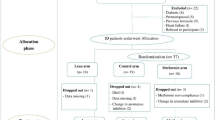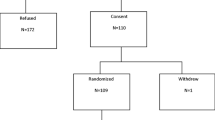Abstract
Purpose
Obesity increases the risk of all-cause and breast cancer mortality. As obese patients have higher levels of aromatase enzyme activity, conflicting results on the effect of body mass index (BMI) of a standard dose aromatase inhibitor on estradiol depletion have been reported.
Methods
We prospectively investigated the effect of BMI on the efficacy of anastrozole in 70 postmenopausal women with early, ER-positive breast cancer to decrease serum estradiol assessed by a high-sensitive assay with a sensitivity limit of 5 pg/ml over 24 months. Additionally, we examined the changes of bone markers expecting an inverse relationship.
Results
Overall, estradiol decreased from 12.6 pg/ml (SD = 5.4) to 4.0 pg/ml (SD = 5.6) over 24 months (p < 0.001). In contrast, carboxy-terminal collagen crosslinks (CTX) and serum aminoterminal propeptide of type I collagen (PINP) increased from 0.26 ng/ml (SD = 0.18) to 0.40 ng/ml (SD = 0.24) and 41.5 ng/ml (SD = 19.7) to 59.1 ng/ml (SD = 29.1) (p < 0.0001 for both). Baseline estradiol comprised significant differences comparing normal weight with overweight (p < 0.01) or obese patients (p < 0.001). After 12 and 24 months, overweight and obese patients showed a slightly, but insignificantly higher concentrations of estradiol compared to normal weight subjects. We found differences of CTX in comparison between normal weight and obese patients (0.33 vs. 0.21 ng/ml; p < 0.023) at baseline. At 12 and 24 months, there was a significant BMI-independent increase in CTX.
Conclusions
Estradiol concentrations in postmenopausal women with early, ER-positive breast cancer on anastrozole were significantly different in normal weight versus overweight or obese patients at baseline, but not at 12 and 24 months. CTX and PINP present a notable increase in the first 12 months of anastrozole treatment, stabilizing thereafter.

Similar content being viewed by others
References
Burstein HJ, Prestrud AA, Seidenfeld J et al (2010) American Society of Clinical Oncology clinical practice guideline: update on adjuvant endocrine therapy for women with hormone receptor-positive breast cancer. J Clin Oncol 28:3784–3796
Buzdar A, Jonat W, Howell A et al (1996) Anastrozole, a potent and selective aromatase inhibitor versus megestrol acetate in postmenopausal women with advanced breast cancer: results of overview analysis of two phase III trials. J Clin Oncol 14:2000–2011
Conroy SM, Maskarinec G, Wilkens LR, White KK, Henderson BE, Kolonel LN (2011) Obesity and breast cancer survival in ethnically diverse postmenopausal women: the Multiethnic Cohort Study. Breast Cancer Res Treat 129:565–574
Diorio C, Lemieux J, Provencher L, Hogue JC, Vachon E (2012) Aromatase inhibitors in obese breast cancer patients are not associated with increased plasma estradiol levels. Breast Cancer Res Treat 136:573–579
Dowsett M, Cuzick J, Ingle J et al (2010) Meta-analysis of breast cancer outcomes in adjuvant trials of aromatase inhibitors versus tamoxifen. J Clin Oncol 28:509–518
Druesne-Pecollo N, Touvier M, Barrandon E et al (2012) Excess body weight and second primary cancer risk after breast cancer: a systematic review and meta-analysis of prospective studies. Breast Cancer Res Treat 135:647–654
Ewertz M, Gtay KP, Regan MM et al (2012) Obesity and risk of recurrence or death after adjuvant endocrine therapy with letrozole or tamoxifen in the breast international group 1–98 trial. J Clin Oncol 30(32):3967–3975
Flegal KM, Carroll MD, Ogden CL, Curtin LR (2010) Prevalence and trends in obesity among US adults. JAMA 303:235–241
Folkerd EJ, Dixon JM, Renshaw L, A’Hern RP, Dowsett M (2012) Suppression of plasma estrogen levels by letrozole and anastrozole is related to body mass index in patients with breast cancer. J Clin Oncol 30:2977–2980
Gnant M, Pfeiler G, Stöger H et al (2013) The predictive impact of body mass index on the efficacy of extended adjuvant endocrine treatment with anastrozole in postmenopausal patients with breast cancer: an analysis of the randomised ABCSG-6a trial. Br J Cancer 109(3):589–596
Goss PE, Hadji P, Subar M, Abreu P, Thomsen T, Banke-Bochita J (2007) Effects of steroidal and nonsteroidal aromatase inhibitors on markers of bone turnover in healthy postmenopausal women. Breast Cancer Res 9:R52
Hadji P, Aapro MS, Body JJ et al (2011a) Management of aromatase inhibitor-associated bone loss in postmenopausal women with breast cancer: practical guidance for prevention and treatment. Ann Oncol 22(12):2546–2555
Hadji P, Asmar L, van Nes JG et al (2011b) The effect of exemestane and tamoxifen on bone health within the Tamoxifen Exemestane Adjuvant Multinational (TEAM) trial: a meta-analysis of the US, German, Netherlands, and Belgium sub-studies. J Cancer Res Clin Oncol 137(6):1015–1025
Kalder M, Ziller V, Kyvernitakis I, Knoll D, Hars O, Hadji P (2013) Influence of compliance on bone mineral density changes in postmenopausal women with early breast cancer on Anastrozole. J Cancer Res Clin Oncol 139(6):915–923
Kyvernitakis I, Ziller V, Hars O, Bauer M, Kalder M, Hadji P (2013) Prevalence of menopausal symptoms and their influence on adherence in women with breast cancer: results of the COMPAS study. Climacteric [Epub ahead of print]
Ligibel JA, Winer EP (2012) Aromatase inhibition in obese women: how much is enough? J Clin Oncol 30(24):2940–2942
McCaig FM, Renshaw L, Williams L et al (2010) A study of the effects of the aromatase inhibitors anastrozole and letrozole on bone metabolism in postmenopausal women with estrogen receptor-positive breast cancer. Breast Cancer Res Treat 119:643–651
Miller WR (2006) Aromatase and the breast: regulation and clinical aspects. Maturitas 54:335–341
Pfeiler G, Konigsberg R, Fesl C et al (2011) Impact of body mass index on the efficacy of endocrine therapy in premenopausal patients with breast cancer: an analysis of the prospective ABCSG-12 trial. J Clin Oncol 29:2653–2659
Protani M, Coory M, Martin JH (2010) Effect of obesity on survival of women with breast cancer: systematic review and meta-analysis. Breast Cancer Res Treat 123:627–635
Renehan AG, Tyson M, Egger M, Heller RF, Zwahlen M (2008) Body-mass index and incidence of cancer: a systematic review and meta-analysis of prospective observational studies. Lancet 371:569–578
Sendur MA, Aksoy S, Zengin N, Altundag K (2012) Efficacy of adjuvant aromatase inhibitor in hormone receptor-positive postmenopausal breast cancer patients according to the body mass index. Br J Cancer 107:1815–1819
Sestak I, Distler W, Forbes JF, Dowsett M, Howell A, Cuzick J (2010) Effect of body mass index on recurrences in tamoxifen and anastrozole treated women: an exploratory analysis from the ATAC trial. J Clin Oncol 28:3411–3415
Siegel R, Naishadham D, Jemal A (2013) Cancer statistics, 2013. CA Cancer J Clin 63:11–30
Acknowledgments
An unrestricted grant by Astra Zeneca Germany sponsored this research.
Conflict of interest
Professor Hadji has received honoraria, unrestricted educational grants, and research funding from the following companies: Astra Zeneca, Novartis, and Pfizer. All other authors report no conflict of interest. The authors alone are responsible for the content and writing of the paper.
Author information
Authors and Affiliations
Corresponding author
Rights and permissions
About this article
Cite this article
Kyvernitakis, I., Knöll, D., Struck, M. et al. Impact of BMI on serum estradiol and bone turnover markers in postmenopausal women with hormone-sensitive early breast cancer treated with anastrozole. J Cancer Res Clin Oncol 140, 159–166 (2014). https://doi.org/10.1007/s00432-013-1557-3
Received:
Accepted:
Published:
Issue Date:
DOI: https://doi.org/10.1007/s00432-013-1557-3




